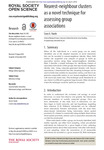Please use this identifier to cite or link to this item:
http://lib.hpu.edu.vn/handle/123456789/22281Full metadata record
| DC Field | Value | Language |
|---|---|---|
| dc.contributor.author | Rands, Sean A. | en_US |
| dc.date.accessioned | 2016-07-18T06:49:09Z | |
| dc.date.available | 2016-07-18T06:49:09Z | |
| dc.date.issued | 2015 | en_US |
| dc.identifier.other | HPU4160438 | en_US |
| dc.identifier.uri | https://lib.hpu.edu.vn/handle/123456789/22281 | en_US |
| dc.description.abstract | When all the individuals in a social group can be easily identified, one of the simplest measures of social interaction that can be recorded is nearest-neighbour identity. Many field studies use sequential scan samples of groups to build up association metrics using these nearest-neighbour identities. Here, I describe a simple technique for identifying clusters of associated individuals within groups that uses nearest-neighbour identity data. | en_US |
| dc.format.extent | 9 p. | en_US |
| dc.format.mimetype | application/pdf | en_US |
| dc.language.iso | en | en_US |
| dc.subject | Biology | en_US |
| dc.subject | Ecology | en_US |
| dc.subject | Social networks | en_US |
| dc.subject | Hierarchies | en_US |
| dc.subject | Behavioural ecology | en_US |
| dc.subject | Social behaviour | en_US |
| dc.title | Nearest neighbour clusters as a novel technique for assessing group associations | en_US |
| dc.type | Article | en_US |
| dc.size | 948KB | en_US |
| dc.department | Education | en_US |
| Appears in Collections: | Education | |
Files in This Item:
| File | Description | Size | Format | |
|---|---|---|---|---|
| 0321_Nearestneighbourclusters.pdf Restricted Access | 948.15 kB | Adobe PDF |  View/Open Request a copy |
Items in DSpace are protected by copyright, with all rights reserved, unless otherwise indicated.
